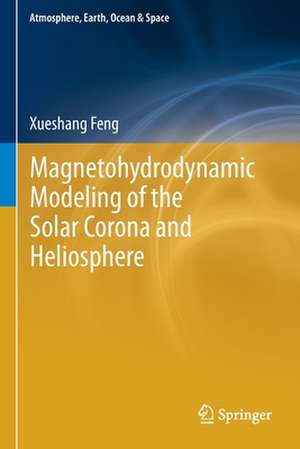Magnetohydrodynamic Modeling of the Solar Corona and Heliosphere: Atmosphere, Earth, Ocean & Space
Autor Xueshang Fengen Limba Engleză Paperback – 28 aug 2020
| Toate formatele și edițiile | Preț | Express |
|---|---|---|
| Paperback (1) | 913.57 lei 6-8 săpt. | |
| Springer Nature Singapore – 28 aug 2020 | 913.57 lei 6-8 săpt. | |
| Hardback (1) | 920.05 lei 6-8 săpt. | |
| Springer Nature Singapore – 28 aug 2019 | 920.05 lei 6-8 săpt. |
Preț: 913.57 lei
Preț vechi: 1114.11 lei
-18% Nou
Puncte Express: 1370
Preț estimativ în valută:
174.81€ • 183.17$ • 144.51£
174.81€ • 183.17$ • 144.51£
Carte tipărită la comandă
Livrare economică 12-26 aprilie
Preluare comenzi: 021 569.72.76
Specificații
ISBN-13: 9789811390838
ISBN-10: 9811390835
Pagini: 772
Ilustrații: XIX, 772 p. 199 illus., 141 illus. in color.
Dimensiuni: 155 x 235 mm
Greutate: 1.09 kg
Ediția:1st ed. 2020
Editura: Springer Nature Singapore
Colecția Springer
Seria Atmosphere, Earth, Ocean & Space
Locul publicării:Singapore, Singapore
ISBN-10: 9811390835
Pagini: 772
Ilustrații: XIX, 772 p. 199 illus., 141 illus. in color.
Dimensiuni: 155 x 235 mm
Greutate: 1.09 kg
Ediția:1st ed. 2020
Editura: Springer Nature Singapore
Colecția Springer
Seria Atmosphere, Earth, Ocean & Space
Locul publicării:Singapore, Singapore
Cuprins
Current status of MHD simulations for space weather.- Finite Volume Methods.- A Finite Volume MHD Code in Spherical Coordinates for Background solar Wind.- 3D SIP-CESE MHD Model on Triangular Prism Grids.- 3D SIP-CESE MHD Model on Six-component Overset Grid System.- AMR Implementation of 3D SIP-CESE MHD Model on Six-component Overset Grid System.- Data-Driven Modeling of Solar Wind.- Coronal Force-Free Field Extrapolations.- Data-Driven MHD Modeling of Coronal Magnetic Evolutions and Eruptions.- Numerical Study of Coronal Mass Ejections.- Future Avenue.
Notă biografică
Xueshang Feng received his Ph.D. degree from Lanzhou University, People’s Republic of China. Then, he worked as a postdoctoral researcher at Beijing University of Aeronautics and Astronautics. He is currently a Professor and the Deputy-Director of the State Key Laboratory of Space Weather, National Space Science Center, Chinese Academy of Sciences. For more than two decades, he has worked extensively on developing numerical methods of space weather modeling and prediction. In 2007, he developed the three-dimensional Solar-Interplanetary space-time Conservation Element and Solution Element (SIP-CESE) MHD model that was validated by employing to simulate the steady-state solar wind, the extrapolation of coronal magnetic field with nonlinear force-free model, and the evolution of coronal mass ejections in the heliosphere. In 2010, he proposed the six-component grid system that consists of six identical component meshes to cover a spherical surface with partial overlap on their boundariesand can avoid mesh convergence and singularities at the pole regions in the common spherical coordinates. He has published more than 300 research papers. He received a Second Class Prize of the National Natural Science Award of China in 2002.
Textul de pe ultima copertă
The book covers intimately all the topics necessary for the development of a robust magnetohydrodynamic (MHD) code within the framework of the cell-centered finite volume method (FVM) and its applications in space weather study. First, it presents a brief review of existing MHD models in studying solar corona and the heliosphere. Then it introduces the cell-centered FVM in three-dimensional computational domain. Finally, the book presents some applications of FVM to the MHD codes on spherical coordinates in various research fields of space weather, focusing on the development of the 3D Solar-InterPlanetary space-time Conservation Element and Solution Element (SIP-CESE) MHD model and its applications to space weather studies in various aspects. The book is written for senior undergraduates, graduate students, lecturers, engineers and researchers in solar-terrestrial physics, space weather theory, modeling, and prediction, computational fluid dynamics, and MHD simulations. It helps readers to fully understand and implement a robust and versatile MHD code based on the cell-centered FVM.
Caracteristici
Provides a brief review of existing magnetohydrodynamic (MHD) models in studying solar corona and the helioshpere Covers all the topics necessary to develop a robust MHD code based on the finite volume method (FVM) Presents applications of the 3D Solar-InterPlanetary space-time Conservation Element and Solution Element (SIP-CESE) MHD model Compares the modeled results with different observations







